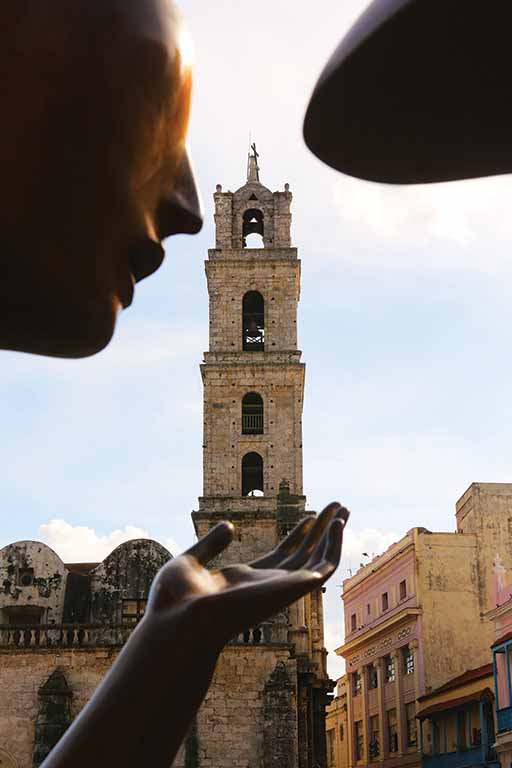Dominating the Plaza de San Francisco on the south side, the Iglesia y Convento de San Francisco de Asís (Oficios, e/ Amargura y Brasil, tel. 07/862-9683, daily 9am-5:30pm, entrance CUC2, guide CUC1, cameras CUC2, videos CUC10) was launched in 1719 and completed in 1730 in baroque style with a 40-meter bell tower. The church was eventually proclaimed a basilica, serving as Havana’s main church, and it was from here that the processions of the Vía Crucis (Procession of the Cross) departed every Lenten Friday, ending at the Iglesia del Santo Cristo del Buen Vieja. The devout passed down Calle Amargura (Street of Bitterness), where Stations of the Cross were set up at street corners.
Aristocrats were buried in the crypt; some skeletons can be seen through clear plastic set into the floor.The basilica and adjoining convent reopened in October 1994 after a complete restoration. The main nave, with its towering roof supported by 12 columns, each topped by an apostle, features a trompe l’oeil that extends the perspective of the nave. The sumptuously adorned altars are gone, replaced by a huge crucifix suspended above a grand piano. (The cathedral serves as a concert hall, with classical music performances hosted 6pm Sat. and 11am Sun. Sept.-June.) Aristocrats were buried in the crypt; some skeletons can be seen through clear plastic set into the floor. Climb the campanile (CUC1) for a panoramic view.
Tower of Basilica San Francisco de Asís. Photo © Christopher P. Baker.
The nave opens to the cloisters of a convent that today contains the Museo de Arte Religioso, featuring religious silver icons.
A life-size bronze statue (by José Villa Soberón) of an erstwhile and once-renowned tramp known as El Caballero de París (Gentleman of Paris) graces the sidewalk in front of the cathedral entrance. Many Cubans believe that touching his beard will bring good luck.
On the basilica’s north side is a garden—Jardín Madre Teresa de Calcuta—dedicated to Mother Theresa. It contains a small Iglesia Ortodoxa Griega, a Greek Orthodox church, opened in 2004.
Many myths surround the enigmatic real-life character known as the “Gentleman of Paris.”
Born in 1899 to a humble family in Vilaseca, Galicia, Spain, José María López Lledín emigrated to Cuba at the age of 13. He worked in various menial jobs until some time in the late 1920s, when he was imprisoned, supposedly for a crime he did not commit. The event unhinged him. When released he’d gone mad.
His hair long and curly, with pointed beard, and wearing a dark suit and cape, José took to the streets as a likable tramp. For five decades he roamed Havana’s streets as El Caballero de París. He never begged for alms but offered gallant words to the ladies, pens and pencils to kids, or perhaps a leaf or a verse in reward for favors. Habaneros regarded him with affection.
Eventually his health declined and with it his ragged appearance. He was admitted to the psychiatric hospital, where he died in 1985. He was buried in the Santiago de las Vegas cemetery. Sculptor José Villa Soberón immortalized El Caballero in bronze outside the Iglesia y Convento de San Francisco de Asís.
Excerpted from the First Edition of Moon Havana.